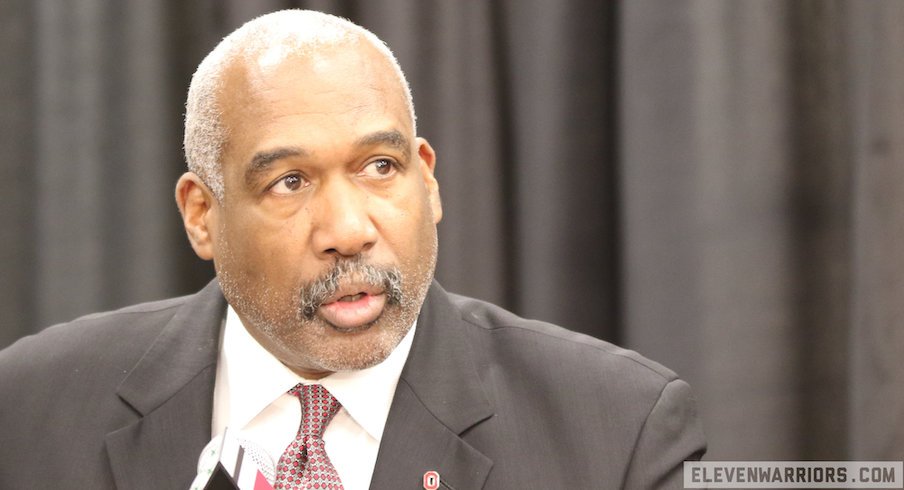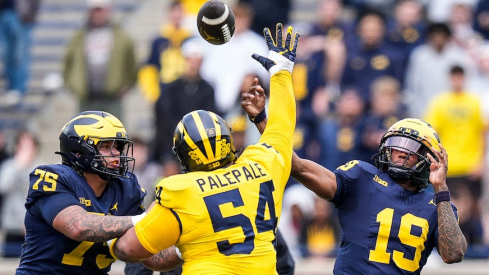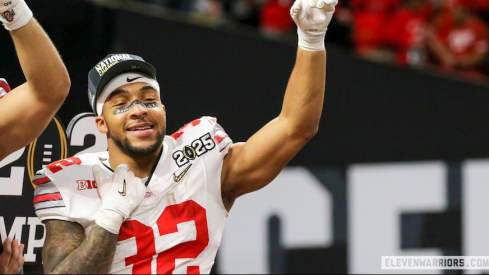As the NCAA moves toward finally allowing student-athletes to be compensated for their name, image and likeness, no university has had a bigger voice in those conversations than Ohio State.
Of the five leaders in name, image and likeness discussions who participated in an NCAA conference call with reporters on Wednesday morning, only two of them are current representatives of member institutions, and both of them are from Ohio State: University president Michael Drake, who is the current chair of the NCAA’s Board of Governors, and athletic director Gene Smith, who is the co-chair of the NCAA’s Federal and State Legislation Working Group, which developed the recommendations approved by the Board of Governors this week.
Smith, in particular, will continue to play a key role both in the national conversation as the NCAA moves toward implementing new rules in January for the 2021-22 academic year and locally in how Ohio State helps guide its athletes through the rule changes. (Drake’s term on the Board of Governors ends in August, and he is set to retire as Ohio State’s president later this year, so he’ll no longer be serving in those capacities when the rules are implemented.)
While Smith has expressed support for allowing NCAA athletes to be paid for their name, image and likeness dating back to October, when the NCAA’s Board of Governors announced it had “voted unanimously” in favor of opening the door for athletes to receive those benefits, he has also said from the beginning that he believes it is necessary for those benefits to be regulated, and that remains his stance, along with the NCAA’s stance at-large.
“It is important that our compliance officers, our faculty reps, our athletic directors and everyone involved in this space contribute to developing the guardrails that we will need around these activities,” Smith said during Wednesday’s conference call. “We need to make sure that with this opportunity and the accountability and the responsibility that we’re providing our student-athletes, we provide the protections necessary so that they can do it with integrity, in the right way and ultimately, not be taken advantage of.”
How exactly that regulation will take place, and what all it will entail, is still uncertain. Drake said the “guardrails” will seek to prevent payments to athletes directly from schools or conferences or tied to their athletic performance or recruitments. Smith said there will be no cap on what student-athletes are allowed to earn – Drake said that was never considered – but Smith does believe the NCAA should determine fair market values for various opportunities to draw the line between genuine compensation for use of name, image and likeness and payments tied to athletic participation that are disguised as NIL benefits.
“We just have to be reasonable,” Smith said. “If I do a deal with Panera Bread and I do two likes (on social media) and they pay me $50,000 for that, I’m not so sure within the realm of what we’re talking about. So we just need to take our time, again continue to educate ourselves, and come up with a process to allow us to at least bring transparency to the activities, so that we can make some decisions.
“We will look for abnormal activity or abnormal payments to ensure that they're consistent with the level of compensation that should be provided relative to the activity. There'll be some subjectivity there because that's the market, but the reality is the reasonable, rational and prudent review of that activity will hopefully allow us to determine if it's appropriate.”
Those potential regulations create questions in themselves, including whether such regulations would by nature place clamps on what student-athletes can earn and whether those regulations will even be enforceable, as state and federal laws could potentially supersede the NCAA’s rule changes. The NCAA’s leadership is in support of Congress passing a federal law so that student-athletes are not governed by separate laws in separate states, but several U.S. Senators and Representatives – including both Democrats and Republicans – expressed concerns on Wednesday about the NCAA’s proposed regulations and its request for an exemption from antitrust laws.
This proposal is one step forward, one step back.
— Chris Murphy (@ChrisMurphyCT) April 29, 2020
The NCAA wants to limit athlete endorsement deals in a way that could make them totally impractical.
And the NCAA wants Congress to give it total power of athletes' compensation. That should be a non-starter. https://t.co/G83zfkHf1i
Walker just told me he wants to compliment the NCAA on moving forward, but "Its a little frustrating to present this in a way that theyre doing these student-athletes a favor.
— Dan Murphy (@DanMurphyESPN) April 29, 2020
I dont want to throw too much shade, but lets not present it like were overextending ourselves." https://t.co/vURHzZo24U
The NCAA’s new rules will continue to prohibit payments to student-athletes that are intended as recruiting inducements, but that doesn’t necessarily mean anyone classified as a booster for a university will be prevented from providing opportunities for student-athletes to receive benefits. Big East commissioner Val Ackerman, who co-chaired the working group with Smith, said the regulations could define “different levels of boosters” and that lower-level boosters could still be able to provide opportunities so long as they are “legitimate and worthwhile” and after a student-athlete enrolls at the university. Smith believes it is important for the NCAA to keep an open mind on that subject, as well.
“Remember our diversity and geography and size of institutions, and there’s some places where everyone in the town is a booster, so we need to be sensitive to that,” Smith said. “And all these decisions around boosters and whether they can be professional service providers, all those type of things, those will be made by divisions, as well. So it’s not just Division I, it’s Division I, II or III. All member institutions will be a part of it.”
Once the NCAA’s new rules are in place, Smith believes it will also be important to educate student-athletes on the new rules to help them protect their eligibility. Student-athletes – just like anyone – will be responsible for paying taxes on any income they receive through name, image and likeness benefits, and any financial aid they receive could also be potentially impacted. So while schools like Ohio State won’t be able to have a hand in arranging any benefits for their student-athletes, they will do what they can to ensure their athletes are as informed as possible on what the rules will and won’t allow them to do.
“We need to make sure that we educate our student-athletes in this space because many of them are on full-ride scholarships and a number of them receive some support from the federal government from Pell grants,” Smith said. “So we need to help them understand that whatever activity they employ could potentially have an impact on their scholarship money.”
Regulations and potential consequences aside, though, Smith believes allowing student-athletes to be paid for opportunities off the field of play is a positive development for college athletics.
“Student-athletes have unbelievable talents and skills beyond their sport that hopefully will allow them to monetize their NIL. From social media influencer, being creative with their music skills, their art skills, their athletic lessons or different promotional activities. So we’re appreciative that (the Board of Governors) approved that,” Smith said.


